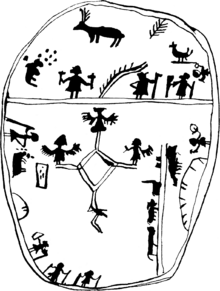Nærøy manuscript
The Nærøy manuscript (Norwegian: Nærøymanuskriptet), originally Relation anlangende Find-Lappernis saa-vel i Norrlandene og Finmarken som udi Nummedalen, Snaasen og Selbye deres Afguderie og’ Satans Dyrkelse, som Tid efter anden ere blevne udforskede og decouvrerede [Treatise on the Sami in Nordland and Finnmark as well as in Namdal, Snåsa and Selbu, their idolatry and worship of Satan, as it has been revealed], is a 1723 treatise by Johan Randulf, then a vicar in Nærøy. Randulf writes about Sami missionary Thomas von Westen's visit to Nærøy in January 1723. Randulf and von Westen summoned the Sami people of the parish to be interviewed and taught at the vicarage.[1]

The treatise is considered an important source on Sami religion, as Randulf builds his description on his own observations in a geographically defined area.[2] Yet, Randulf is sometimes inaccurate about when he describes his own observations and when he refers to von Westen's observations from other districts.[3]
Treatise
Randulf found there were mountains throughout Namdalen and Helgeland that were considered holy by the Sami. These included holy mountains on the coast, such as Heilhornet in Bindal and Lekamøya at Leka. Randulf names three locations for sacrifices: Teplingfjellet in Foldereid, Folldalen in Høylandet og Kverndalsfjellet/Kvernvassfjellet in Fosnes.
Randulf makes a distinction between the sea Sami people («Søe-Finner») and the mountain Sami («Field-Finner»), and describes them as having different ways of living and making a living. Unlike the non-Sami Norwegians the sea Sami had no taboos against horse meat.
Thomas von Westen owned a Sami drum of an Ume Sami type, with one dividing, horizontal line and with a sun symbol in the lower part. The treatise describes and interprets the symbols of the drum.[4][5]
Edition
A copy of the original manuscript is kept at the Gunnerus Library, Trondheim.[6] It was published by Just Qvigstad in Kildeskrifter til den lappiske mythologi; bind 1; in the series Det Kongelige Norske Videnskabers Selskabs skrifter (1903).[7]
References
- Håkon Hermannstrand Nærøykirka og samene på kysten
- Roald E. Kristiansen. Samiske kildeskrifter
- Hans Mebius. Bissie, studier i samisk religionshistoria. Jengel förlag, 2007. ISBN 91-88672-050. Page 34
- Roald E. Kristiansen. «Samisk religion». In: Geir Winje. Guddommelig skjønnhet, kunst i religionene. Universitetsforlaget, 2001. ISBN 82-15-00053-3. Pages 245-253
- Trond Gabrielsen. «Thomas von Westens runebomme 1723»; Ságat, 31 December 2009 – with a description of the symbols and an interpretation of them.
- web version of the manuscript
- Kildeskrifter til den lappiske mythologi; e-book